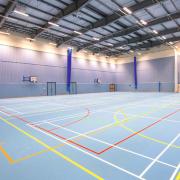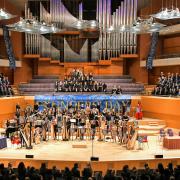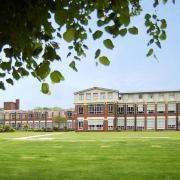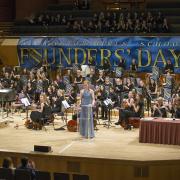What is it like to live within the historic walls of Chetham's School of Music in Manchester? Principal Claire Moreland invites us over the threshold WORDS BY JANET REEDER
PHOTOGRAPHY BY KIRSTY THOMPSON
Claire Moreland regards herself as a custodian of the Manchester home she’s lived in for the past 10 years: after all it is a medieval Grade 1 listed gem right in the heart of the city.
The reason? Well, Claire is head of the world-famous Chetham’s School of Music and as part of her role she lives in a flat in the oldest and some may even think, spookiest, part of the building.
And it is here in the lofty drawing room, beneath a canopy of 15th century beams, that she has entertained some of the most eminent people in the land, including, arguably the most important, HM The Queen.
As we talk about Claire’s life in one of the city’s most respected institutions, the sounds of piano and violin playing a selection by Svendsen, Iturralde and Ibert, float up from the beautifully preserved Baronial Hall. It is here lunchtime concerts are held for the Humphrey Chetham Club, members who have pledged �1,000 a year to support the school’s capital development that will this month be realised in a new �31m state-of-the-art building.
We sit at a long dining table, facing a spectacular armoire, which turns out to be a genuine Chippendale, not, Claire hastens to add, her own but belonging to Chetham’s.
The flat dates back to the 1422 origins of the old building, constructed as priest’s residence for the Manchester Parish Church, now Manchester Cathedral and after several incarnations, including a manor house for the Dukes of Derby, it passed into the hands of Humphrey Chetham in 1663 who turned it into a charity school. It wasn’t until 1952 that it became known for music.
The oldest wing of the building is remarkable with its atmospheric library - the oldest in the world - ancient courtyard, corridors and passageways so reminiscent of the colleges of Oxford and yet the school itself is quite discreet; many people won’t even know it is here on this site near Victoria Station, the Triangle and opposite the new soon-to-open Museum of Football.
Claire considers herself very fortunate to have so many wonderful things on her doorstep, from the shops and restaurants to the theatres and the galleries. She has become very fond of the city which is now her home.
‘I was born in Bath because my father was what was part of the Admiralty and we travelled all over the world so I had chunks of my childhood in places like Singapore, so I don’t feel I’m from anywhere actually,’ she explains.
‘I’ve been here since 1999 and the whole place has sucked me in.’Although head of one of the leading music schools in the world, Claire doesn’t profess to being musical.
‘I play guitar, I love music otherwise I wouldn’t be here but I’ve come up through school management,’ she says.
Before Chetham’s, Claire was the first-ever female deputy head at Rugby School. Of course the headship at the world-renowned music school was a great opportunity but she also admits that the apartment she lives in appealed to her too.
‘I love the Gothic, the genuine thing and the revivalist and I saw the flat and thought all my things would fit in quite well there,’ she reveals.Among those pieces is a suit of armour, which she is keen to point out is not original.
‘My mother lives in Cornwall near an armourer who creates armour for all the feature films and he had a sale. The helmet and breastplate are completely mismatched. The helmet is Norman and the breastplate is Tudor. I do put it on occasionally and I hold student functions in here occasionally and they like to put it on.’
Few people can claim to have an original medieval ‘peephole’ in their home but Claire does. It allows you to do more than ‘peep’. It’s actually a wooden gap through which we can spy on the performance going on in the Baronial Hall below.
In fact, this is quite the place for spying and Claire admits that she has been known to shout down to pupils in the courtyard below her mullioned windows.
While public life and private life are somewhat blurred by the fact that she lives in the school, it’s not like she’s alone. She shares the school with the 290 pupils aged eight to 18 who board. The students come from every background – it may be for boarders but children if they are musically gifted are given financial help whatever their circumstances.
It is indeed a home like no other...one where music is as much a part of its fabric, as much as the antique clocks and candlesticks that adorn the space. And that’s what makes it completely unique.


























